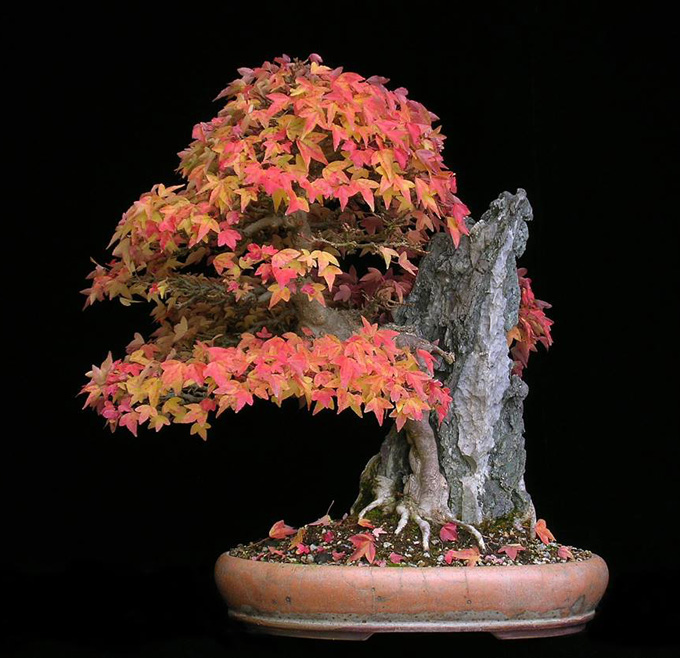 Root-over-rock Trident maple by Wolfgang Putz. The photo is from Bonsai Master on facebook as are all three photos in this post. Here are a couple earlier posts on Wolfgang’s bonsai (from May, 2009 and from August 2012).
Root-over-rock Trident maple by Wolfgang Putz. The photo is from Bonsai Master on facebook as are all three photos in this post. Here are a couple earlier posts on Wolfgang’s bonsai (from May, 2009 and from August 2012).
All three of these photos are from someone called Bonsai Master (facebook). When I saw them, I was struck by three things:
1. All three are excellent bonsai.
2. The quality of the photos is also excellent. It make a big difference when people go to the trouble to take a good shot. Facebook (but not just facebook) is overflowing with poorly photographed trees.
3. Bonsai Master went to the trouble to attribute all three to their rightful owners (they’re pretty good about this, but they let some slip). If you’ve been following Bark, you may have noticed that this is a reoccurring theme. Many people don’t go to the trouble to attribute bonsai to the artist (or owner). Mostly, I think this is simply laziness. In some cases I wonder if there’s not a little vanity too (if you read the comments, it’s clear that people sometimes think the person who posted is the owner).
Attribution is important. Unless you can’t find the information, you wouldn’t show a painting without mentioning the painter, nor a poem without the poet.
While we’re at it, we might as well brag just a bit and mention links. You might notice that we always try to link to the source (often we provide other relevant links as well ). We know we might lose you this way (at least for a while) but we also know that many of you appreciate this practice and in the name of promoting bonsai art and free flowing information, why not?
 Bonsai Master’s caption on this one says “Amazing..! Ligustrum Vulgare by Andrew Buettner. Thank you.” Ligustrum vulgare is Common privet (think hedges). Here’s Andrew’s facebook page.
Bonsai Master’s caption on this one says “Amazing..! Ligustrum Vulgare by Andrew Buettner. Thank you.” Ligustrum vulgare is Common privet (think hedges). Here’s Andrew’s facebook page.
 We love larches and this one has a lot to love. Here’s Bonsai Master’s caption: “Beautiful. By Hans van Meer, Karomoto Bonsai Art.. Thank you.”
We love larches and this one has a lot to love. Here’s Bonsai Master’s caption: “Beautiful. By Hans van Meer, Karomoto Bonsai Art.. Thank you.”
While in the military, I used the word “reoccuring” and got fussed at by a high ranking officer. He said the proper word was “recurring.” Please don’t let this mistake reoccur.
… and yet reoccur is a proper word. Something that recurs happens repeatedly, perhaps at regular intervals. Something that reoccurs happens again, but not necessarily repeatedly or at regular intervals. For example, the sunrise recurs, and an unpredictable event that happens to occur more than once—such as an earthquake or a financial crisis—reoccurs.
The Ligustrum is very nice, but the pot could have been a smaller. Perhaps because their root system is very aggressive (at least here in Ft. Laud.) the free form pot allows for less repotting
and more time for refinement. As far as grammar remember this.
Let’s eat grandma or Let’s eat, grandma … punctuation saves lives!!!
Hi Dan,
Thanks for you input. However, I respectfully disagree. It’s a slab with a landscape planting and not a pot and the perspective seems fine all the way around. What I would take issue with is the boring straight line path in the landscape. Still, I like it a lot.
And where’s my grammatical faux pas? Not that I don’t make them all the time, but I can’t find it.
Herr Wolfgang was part of the first wave of European artists to post on the old IBC. Those were the days!
The Ligustrum is nice. I agree with Wayne that the path is too straight, but what really gets me are the stones placed like button eyes on either side.
Thanks Maggie,
Agreed. Bu then there’s that brilliant green moss.
Wayne, we re-create what we see. In the absence of forest trees or other blocking material, pathways tend to be straight lines. We want to get from Here to There. The linearity is at least mitigated by the angle and the way it disappears behind the trunk as if over a hill. I wonder where it goes? And Andrew would know about the rocks.
Hi Zack,
Good point. Natural paths, human or animal, tend to be more or less straight where there are no obstacles. Maybe a more compelling landscape would involve an obstacle or two and a curved path.